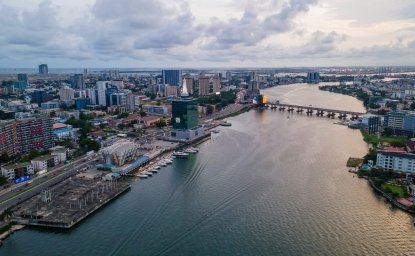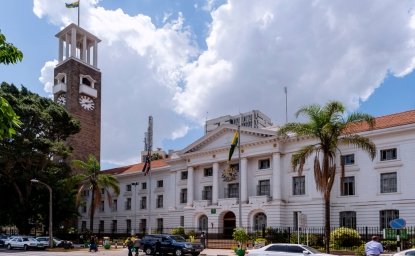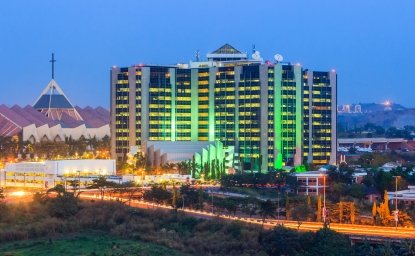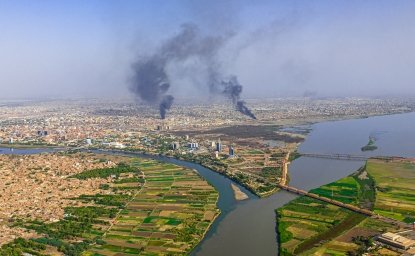
A blog of the Africa Program
On May 13th, 2000, the cover of the Economist displayed a map of Africa overlaid by an image of a man straining under the weight of a shouldered weapon. Above the image was the title “The Hopeless Continent.” This image, which reached the Economist’s readership of nearly 1 million readers globally, distilled a continent of almost 1.5 billion people living in 54 diverse, multicultural, and polyethnic nations into three condemning words and an image of war and strife.
This widely cited cover remains one of the most poignant examples of Africa’s false portrayal in the media. Sadly, such skewed characterizations of Africa as a despairing monolith remain common. Throughout the 21st century, mainstream American media often projected a biased and damaging depiction of Africa through a near-constant flow of crisis-centric coverage and stereotypes. From childhood, Americans are bombarded with harmful portrayals of Africa and these portrayals are far from harmless. The American media’s wide reach and agenda-setting qualities have had profound and adverse effects on American perceptions of the continent and the world’s engagements with it that have led to coverage overly focused on crisis, conflict, disaster and most recently, great power competition.
American News Norms
The American media has a large amount of power and influence, with four of the five most circulated English-language news sites worldwide based in the US. As such, American mainstream media shapes perceptions and narratives far beyond its borders. For many Americans, this media is the only means through which they will interact with the African continent, especially with African studies absent from school curriculums and levels of American travel to African nations remaining low.
Moreover, the American media follows a unique set of news norms, particularly in its foreign reporting, which dictate which pieces will be published and highlighted. According to media scholars, stories are chosen for publication if they (1) have a strong impact on the lives of American audience members; (2) involve violence, conflict, disaster, or scandal; (3) are familiar; (4) are proximate; and (5) are timely and novel. These norms have specific consequences for stories about African nations and affairs. They function as an unofficial story selection criteria and formulate the basis for the journalistic adage “If it bleeds, it leads,” a colloquial reference to how journalists often cater to the negativity bias of readers, as they are more physiologically activated by negative rather than positive stories. Stories most relevant and familiar to US audiences are more likely to be published, reducing the chance stories concerning Africa will materialize. Congruently, the norms of timeliness and proximity ensure a greater number of stories are generated from countries where media outlets have reporters present on the ground. Unfortunately, the number of foreign correspondents in Africa has dropped significantly since 1998, due in good part to the ease of information accessibility through technology and to declining protections for freedom of the press across the continent. When stories about Africa do appear, these news norms increase the chances their coverage will be negative and focused on chaos and conflict rather than growing cooperation and progress.
These norms continue to shape media coverage in the 21st century. One content analysis revealed that ‘crisis news’ was the most common characterization of stories on Africa and a recent study found that during the US-Africa Leaders Summit—a historic meeting of African leaders in Washington resulting in billions of dollars of investment pledges and progress on crucial issues—the media instead focused on West Africa’s Ebola outbreak, reporting the word “Ebola” more often than “US” and “summit” combined. Additionally, according to the Columbia Journalism Review, while America's ten most viewed newspapers and magazines contained 245 articles referencing poverty in Africa, only five mentioned gross domestic product growth.
Why Does This Matter? Connecting The Mainstream Media and Public Opinion
Operating within a set of norms that skew coverage of international events is particularly harmful, as the media has a distinct ability to shape the way readers think about specific topics through a mechanism known as the agenda-setting function of mass media. In their inaugural study on media influence, researchers Maxwell E. McCombs and Donald L. Shaw coined the term “agenda-setting function” to describe how “readers learn not only about a given issue but also how much importance to attach to that issue from the amount of information in a news story and its position.” The researchers found that news impacts people's thoughts about certain topics, and more recent research into agenda-setting further expands on the phenomenon.
A phenomenon known as second-level agenda setting suggests that the press not only signals how to think about an issue, but also what to think based on the way readers form mental linkages between media depictions and the topics itself. This expands the role of the media from a medium that merely signals the importance of an issue to one that includes which attributes readers will attach to certain topics. Subsequent studies have confirmed this theory, finding that the more negative coverage nations receive, the more likely readers think negatively about the nation.
Conclusion
With great reach, must come great responsibility. The way the media reports on African nations impacts the way the public perceives the continent, and increasingly, a biased depiction of Africa is contributing to tensions in US-Africa relations. African leaders continue to push back against the notion of the continent as a “geostrategic battleground” between the United States, Russia and China, yet news sources continue to obsess over the lens of the United States “losing” on the continent. For African leaders, this frustrating fixation comes after decades of relative ambivalence from American leaders toward African nations, and is straining bilateral relations.
This skewed depiction of Africa in the media may also have consequences on US foreign policy toward African nations. Just as media coverage of certain topics impact public perceptions, so too can it impact the mindsets of policymakers, who are also media consumers themselves. In one poignant example of this impact, former President George H.W. Bush stated that he “learned more from CNN than the CIA” as he led America’s involvement in the Gulf War — a reference to what many now call the CNN effect.
For nations that suffers from high levels of negative, conflict-centric coverage in the media alongside historically misguided foreign policy, media depictions matter. Despite decreasing poverty rates, increasing economic development, greater child mortality rates, and greater rates of education in many African countries, American journalism has been slow to shift away from its constant stream of crisis coverage, and this negative coverage of Africa evokes a misguided image of the continent from the false public perception it supports.
However, it is important to note that portraying a more holistic story of African nations does not mean censoring negative reporting, nor does it suggest that stories of issues such as famine and disease be eliminated. Both international and local journalists have served as crucial forces in bringing injustice to light and their reporting has brought awareness atrocities such as the Rwandan Genocide, famine in Sudan, and apartheid in South Africa, and have compelled policymakers to act. But just as it is critical to tell these stories and expose instances of horrific injustice, it is equally important to highlight African nations' rapid advancements, strategic importance, and autonomy from great power competition.
Recently, there have been positive changes. A recent New York Times series, Old World, Young Africa, discussed Africans’ creativity and shaping of the French language. US foreign policy is changing as well, shifting from aid-centric to focus on long-term partnerships and trade. Media stories emerging about the continent must continue to follow this trend. Western news organizations must reevaluate the norms they use in story selection and provide training for their journalists on how to report on developing nations to avoid parachute journalism and stereotypical depictions. Moreover, when reporting on challenges and suffering, journalists need to take responsibility for conveying the complex roots of conflict and strife. Most of all, the US government and American news outlets must engage with African journalists who are reporting on their local and national stories, often against great odds. As freedom of the press faces unprecedented attack, local journalists must be supported across the continent, for it is these journalists who know best the stories that must be told and how to tell them.
Author


Africa Program
The Africa Program works to address the most critical issues facing Africa and US-Africa relations, build mutually beneficial US-Africa relations, and enhance knowledge and understanding about Africa in the United States. The Program achieves its mission through in-depth research and analyses, public discussion, working groups, and briefings that bring together policymakers, practitioners, and subject matter experts to analyze and offer practical options for tackling key challenges in Africa and in US-Africa relations. Read more

Explore More in Africa Up Close
Browse Africa Up Close
The Innovative Landscape of African Sovereign Wealth Funds



